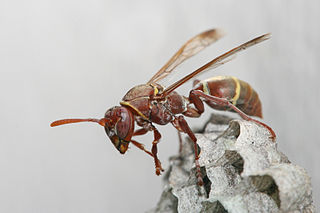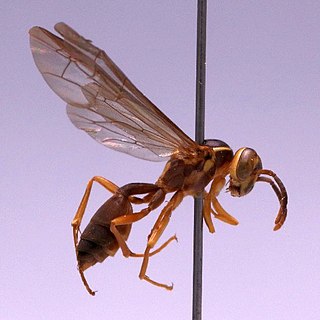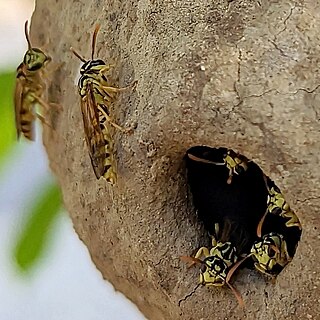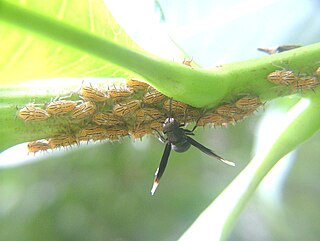
The Polistinae is a subfamily of eusocial wasps belonging to the family Vespidae. They are closely related to the wasps and true hornets of the subfamily Vespinae, containing four tribes. With about 1,100 species total, it is the second-most diverse subfamily within the Vespidae, and while most species are tropical or subtropical, they include some of the most frequently encountered large wasps in temperate regions.

Honey wasps are species in the genus Brachygastra of the family Vespidae. Brachygastra comprises 17 species of social paper wasps. The ancestral species are thought to have diverged about 32 million years ago within diverse Amazonian rainforest. Subsequent speciation within the genus is thought to have mostly occurred between 23 Ma and 10 Ma, during the time of the Andean uplift when the landscape was significantly altered due to tectonic activity. The current cladistic organisation of the genus has been heavily reliant on morphological characteristics.

The Epiponini are a large and diverse tribe of social wasps inhabiting the Neotropical region, with some species' ranges extending into the Nearctic region.

The Central American paper wasp is a nocturnal eusocial wasp. It is famous for its swarm based emigration behavior, and is native to the lowlands of Central and northern South America. This species has developed special night vision adaptations to facilitate their night-time swarming and foraging behavior and has important medicinal properties for the Pankararú people of Brazil.
Apoica flavissima is a paper wasp found primarily in South America. The species is distinguishable by its light coloring, unique single comb nests, and nocturnal nature. A notable feature of this species is the size dimorphism between queens and workers. Unlike most Vespidae wasps, Apocia flavissima queens are smaller than their worker counterparts which results in unique intraspecies relationships.

Brachygastra lecheguana, formerly known as Nectarina lecheguana, is a species of dark paper wasp found across North and South America. It nests in underbrush in grassland-type environments, and produces honey, characteristic of the genus Brachygastra.

Polybia occidentalis, commonly known as camoati, is a swarm-founding advanced eusocial wasp. Swarm-founding means that a swarm of these wasps find a nesting site and build the nest together. This species can be found in Central and South America. P. occidentalis preys on nectar, insects, and carbohydrate sources, while birds and ants prey on and parasitize them. P. occidentalis workers bite each other to communicate the time to start working.

Agelaia vicina is a species of wasp in the genus Agelaia. They are neotropical social wasps known to have the largest colony sizes and nest sizes among social wasps, with some colonies exceeding over one million individuals. They are predators of land arthropods, consuming both insects and spiders alike. Recent sperm morphology studies have shown that although Vespidae belong to the superfamily Vespoidea, A. vicina may be more phylogenetically related to Apoidea.

Angiopolybia pallens is a species of social wasp predominantly found in South America. The wasp is generally seen in Brazilian rainforests. This species was discovered by Lepeletier in 1836. It typically feeds on nectar and carrion. In fact much of its feeding behavior and impact on humans is centered on feeding on animal carcasses. The wasp species displays a caste differentiation that can be seen by difference in ovarian development. Additionally they have a unique colony establishment procedure. It begins with a few individuals from the nest leaving to find a good site and then the rest of the colony follows using specific communication signals that are further discussed in this article.

Agelaia pallipes is a species of social paper wasp found from Costa Rica to Brazil, Argentina and Paraguay. A. pallipes is ground-nesting and is one of the most aggressive wasps in South America. This species is a predator of other insects, including flies, moths, and ground crickets, as well as baby birds.

Leipomeles dorsata is a neotropical paper wasp that is found across Central America and northern South America. It is a eusocial wasp with little differentiation between reproducing and non-reproducing females. In fact, workers can become temporary reproductives if the main reproductives are killed, allowing reproduction to continue until the main reproductive population recovers. The colony cycles through different ratios of main reproductive females and subordinate reproductive females, starting with few or no primary reproducing females, and increasing until there are only main reproductives.
The African swarm-founding wasp, Polybioides tabidus, is a social paper wasp from the order Hymenoptera that is typically found in Central Africa. This wasp is unique in that it exhibits cyclical oligogyny, meaning queen number varies with colony cycle. After several generations of production of workers and future queens, a subset of many workers and queens leave the original colony to begin a new one. The new colony does not produce new queens until current queens from the old colony have died. P. tabidus has been observed to display both predator and scavenger behavior, depending on the food sources available.
Protopolybia exigua is a species of vespid wasp found in South America and Southern Brazil. These neotropical wasps, of the tribe Epiponini, form large colonies with multiple queens per colony. P. exigua are small wasps that find nourishment from nectar and prey on arthropods. Their nests are disc-shaped and hang from the undersides of leaves and tree branches. This particular species of wasp can be hard to study because they frequently abandon their nests. P. exigua continuously seek refuge from phorid fly attacks and thus often flee infested nests to build new ones. The wasps' most common predators are ants and the parasitoid phorid flies from the Phoridae family.

Polybia sericea is a social, tropical wasp of the family Vespidae that can be found in South America. It founds its colonies by swarming migrations, and feeds on nectar and arthropods.

Polybia emaciata is a Neotropical swarm founding wasp that is mainly found in South America. This eusocial species has a unique colony structure in which multiple queens are present. Workers and queens are not morphologically distinct, but the high amount of relatedness maintained in the colony ensures that workers police each other. Polybia emaciata relies on a diet of liquid nectars which is supplemented with prey insects, particularly flies. It is well known for being one of only three wasp species in the genus Polybia that uses mud as the primary material for building its nest. Polybia emaciata is one of the least aggressive wasp species in the genus Polybia, and is known for its distinctive defensive behavior.

Synoeca surinama is a Neotropical swarm-founding wasp of the tribe Epiponini. It is known for its metallic blue and black appearance and painful sting. S. surinama builds nests on tree trunks and can be found in tropical climates of South America. When preparing to swarm, there are a number of pre-swarming behaviors that members of S. surinama colonies partake in, such as buzzing runs and occasional brood cannibalism. In S. surinama, social environmental conditions determine the caste ranks of individuals in the developing brood. Unlike less primitive Hymenoptera species, S. surinama display little morphological variation between egg laying queens and workers. S. surinama wasps visit flowering plants and are considered pollinators. When these wasps sting, the stinger is left in the victim and the wasp ultimately dies.
Brachygastra scutellaris, a honey wasp, is a Neotropical, swarm-founding species that is found in South America and has a medium-sized population of 100–1000 individuals per colony. It stores large amounts of nectar in its nest for the production of honey, and it was even found that at certain times of the year, the nectar is toxic to humans, as they will extract nectar from hallucinogenic plants, depending on the season.
Protopolybia chartergoides, also known as Pseudochartergus chartergoides, is a species of wasp within the genus Protopolybia. It is a social wasp found in southern Central America and northern South America.

Polybia paulista is a species of eusocial wasp occurring in Brazil, Paraguay, and Argentina.

Parachartergus is a genus of epiponine social wasps belonging to the subfamily Polistinae. Species include:















